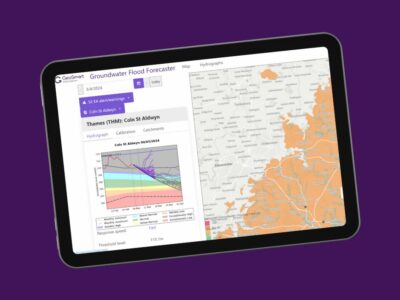How can SuDS reports improve the UK’s water quality?
Contents
- Why is the UK’s water quality so bad?
- How can a GeoSmart SuDS report help you to reduce water pollution?
- Want to request a GeoSmart SuDS report?
Water is the word of the moment.
Drought conditions in the UK and across Europe are proving hazardous for farming and have been predicted to last until October at the earliest.
The UK’s water quality has similarly been put under the spotlight, with water companies coming under fire for allowing raw sewage to overflow into the nation’s watercourses.
In a review of the environmental performance of England’s nine water companies across 2021, the Environment Agency (EA) revealed that a staggering 62 serious pollution incidents had occurred – the highest number recorded since 2013.
Conclusions drawn from this analysis were so poor that the EA’s Chair, Emma Howard Boyd, threatened criminal prosecutions for repeat offenders of pollution.
Progress for holding companies accountable does appear to be taking shape in the form of government plans to make it a legal duty for England’s water companies to upgrade their water treatment works in ‘nutrient neutrality’ areas by 2030.
However, more changes need to be enacted if we are to drastically reduce pollutants from the nation’s watercourses.
Why is the UK’s water quality so bad?
Agricultural practices, methods of water disposal and runoff from transport infrastructure and urban areas are the top causes of water pollution.
According to the Rivers Trust, overuse of fertilisers, pesticides, and other agricultural chemicals impact two-thirds of the UK’s ‘failing rivers’ with the release of raw sewage by water companies affecting over half and urban runoff contaminating a quarter.
Evidence for the extent of pollution in the UK’s watercourses has been made clear in the River Trust’s sewage map; there are nearly 15,000 sewer storm overflows in England and Wales – points in rivers or sea where raw sewage is discharged into watercourses without treatment.
This nationwide problem could easily be exacerbated too if water mains and drainage systems are not updated in the next few years.
In the white paper, Water 2050, Water UK has estimated that without such measures, the number of burst water mains could increase by 20 per cent with instances of flooding and pollution from sewers rising by six per cent.
If this happens, several already problematic issues will become worse. These include:
- An increased complexity in the treatment of drinking water.
- More fish, insects and plants being suffocated as rising algae numbers, which thrive on sewage nutrients, consume the available oxygen supplies in our watercourses.
- The further destruction of habitats and biodiversity, leading to a breakdown of local ecosystems.
- Damage to the economy through remediation costs caused by the spread of polluted flood water to homes, buildings and infrastructure.
How can a GeoSmart SuDS report help you to reduce water pollution?
The situation of water quality in the UK is dire but not without hope.
In the government’s declaration of plans to reduce water pollution last month, a Nutrient Mitigation Scheme was proposed to increase farm inspections and reward farmers and land managers for reducing water runoff and investing in wetland and woodland expansion.
The scheme would be particularly beneficial to those involved in the construction of new properties and developments as it would enable local planning authorities to grant sustainable developments in areas with nutrient pollution issues.
Sustainable drainage reports, also known as SuDS reports, would be required in such circumstances and provide professionals like architects, planning consultants, house builders and developers the chance to help tackle water pollution and quality.
The reason for this is that these reports inform the recipient of a development site’s suitability for sustainable drainage systems by identifying the ground’s potential for water infiltration, the site’s topography and any existing drainage systems.
If a SuDS report outlines a need and suitability for sustainable drainage systems, and you have then implemented this, you can expect both a smoother planning approval process and for your development site to help reduce polluted water runoff from entering nearby watercourses.
This is due to the fact that SuDS:
- Allow water to soak into the ground (infiltration).
- Reduce the volume of polluted water entering nearby watercourses by storing it in solutions such as retention ponds, wetlands and detention basins.
- Can transfer polluted water into the atmosphere via vegetation through the process of evapotranspiration.
- Can intercept and store flood water before it overwhelms water treatment systems and sewers and overflows into watercourses.
Want to request a GeoSmart SuDS report?
At GeoSmart, we offer three different types of SuDSmart reports so you can choose the one which best suits your needs. Whether this is a standard SuDSmart Report, SuDSmart Plus or SuDSmart Pro, we will ensure your requirements are met.
If you don’t know exactly what you need, you can explore the different features of our SuDS reports and how you can request one on our website.



